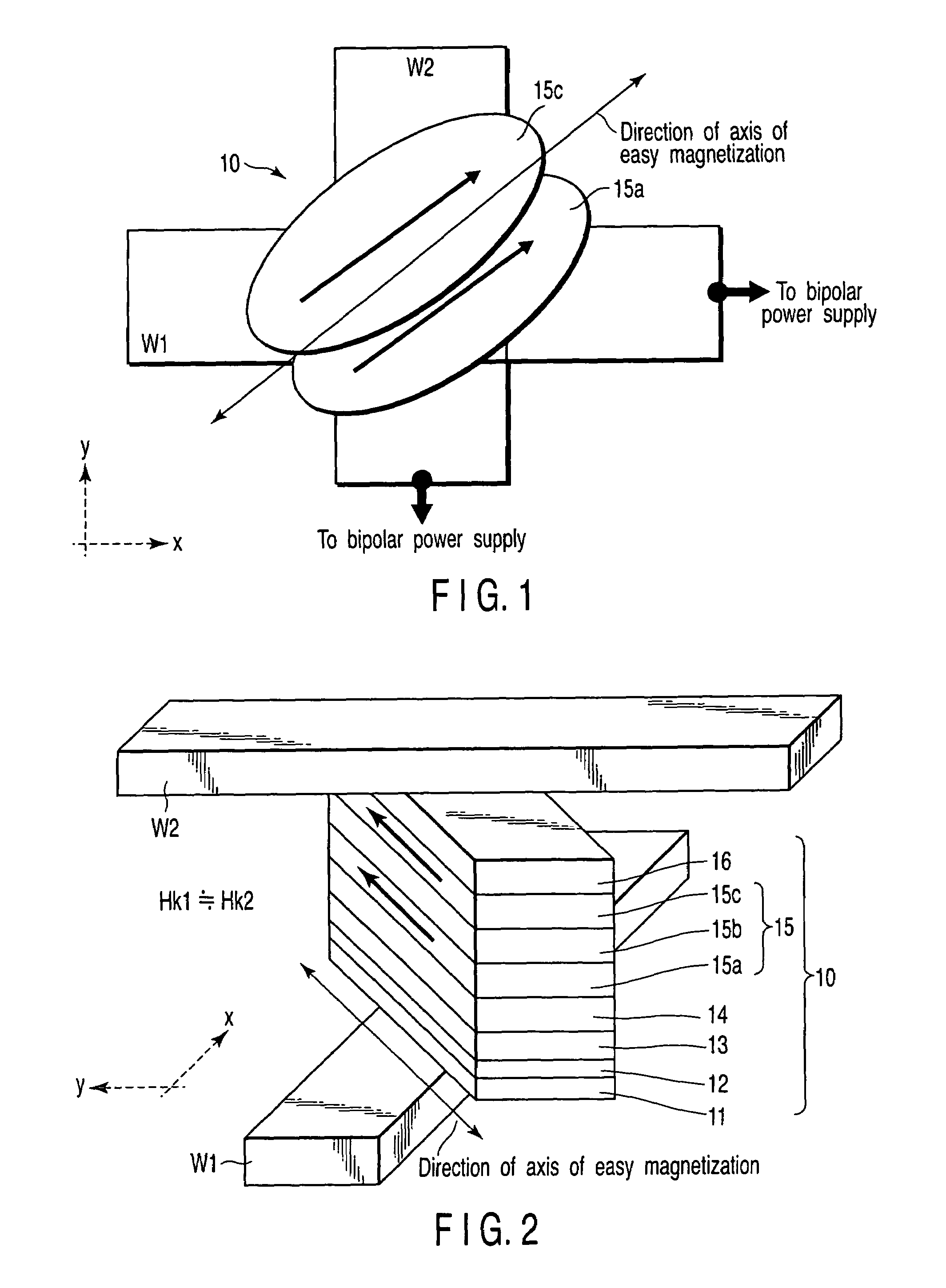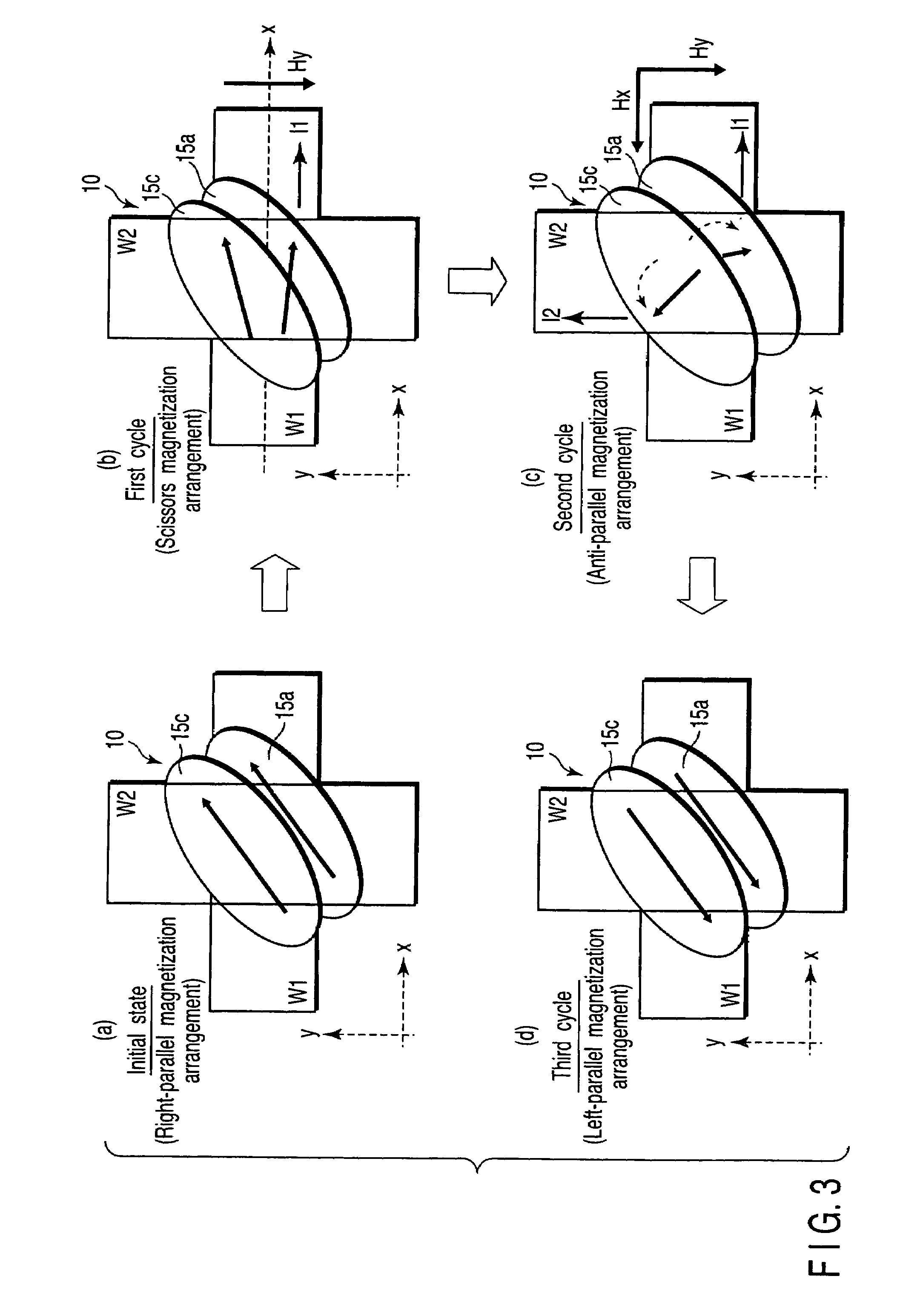Magnetic memory device and write method of magnetic memory device
a magnetic memory device and write method technology, applied in static storage, information storage, digital storage, etc., can solve the problems of increasing the reversal field of the recording layer of the mtj element, the reversal field can be made very small, and the capacity cannot be increased. , to achieve the effect of large memory energy, small reversal field, and no increase in magnetic static energy
- Summary
- Abstract
- Description
- Claims
- Application Information
AI Technical Summary
Benefits of technology
Problems solved by technology
Method used
Image
Examples
case 1
(Case 1)
[0074]In Case 1, different anisotropy magnetic fields Hkint1 and Hkint2 are generated by the actual magnetic anisotropy of the two ferro-coupled ferromagnetic layers 15a and 15c. When the recording layer 15 made of, e.g., CoFe / Cu / NiFe is used, the anisotropy constants (induced magnetic anisotropy constants) of the ferromagnetic layers 15a and 15c are set to 1×105 dyn / cm3 and 1×104 dyn / cm3. The anisotropy magnetic fields of the ferromagnetic layers 15a and 15c are set to Hkint1≈20 [Oe] and Hkint2≈5 [Oe].
case 2
(Case 2)
[0075]In Case 2, different saturation magnetization constants M1 and M2 are set for the two ferro-coupled ferromagnetic layers 15a and 15c. The recording layer 15 made of, e.g., Ni60Fe40 / Cu / Ni80Fe20 (the number indicates the atomic percentage [%]) is used. The short length of the MTJ element 10 is set to about 140 nm. Thicknesses t1 and t2 of the ferromagnetic layers 15a and 15c are set to about 2 nm. In this case, the saturation magnetization constants of the ferromagnetic layers 15a and 15c are set to 4πM1≈14000 gauss and 4πM2≈9500 gauss. The anisotropy magnetic fields Hk1 and Hk2 of the ferromagnetic layers 15a and 15c are set to 100 to 200 [Oe] and 50 to 100 [Oe].
case 3
(Case 3)
[0076]In Case 3, different thicknesses t1 and t2 are set for the two ferro-coupled ferromagnetic layers 15a and 15c. The recording layer 15 made of, e.g., NiFe / Cu / NiFe is used. The short length of the MTJ element 10 is set to about 140 nm. The saturation magnetizations (4πM1 and 4πM2) of the ferromagnetic layers 15a and 15c are set to about 9,500 gauss. In this case, the thicknesses of the ferromagnetic layers 15a and 15c are set to t1≈3 nm and t2≈1.5 nm. The anisotropy magnetic fields Hk1 and Hk2 of the ferromagnetic layers 15a and 15c are set to 100 to 200 [Oe] and 50 to 100 [Oe]. The thicknesses t1 and t2 of the two ferro-coupled ferromagnetic layers 15a and 15c are preferably different by about twice.
[0077]According to Cases 1 to 3 described above, the ferromagnetic layers 15a and 15c can have the different effective anisotropy magnetic fields Hk1 and Hk2. For this reason, when appropriate write current values are set, scissors magnetization arrangements which sandwich t...
PUM
 Login to View More
Login to View More Abstract
Description
Claims
Application Information
 Login to View More
Login to View More - R&D
- Intellectual Property
- Life Sciences
- Materials
- Tech Scout
- Unparalleled Data Quality
- Higher Quality Content
- 60% Fewer Hallucinations
Browse by: Latest US Patents, China's latest patents, Technical Efficacy Thesaurus, Application Domain, Technology Topic, Popular Technical Reports.
© 2025 PatSnap. All rights reserved.Legal|Privacy policy|Modern Slavery Act Transparency Statement|Sitemap|About US| Contact US: help@patsnap.com



